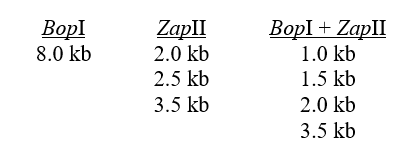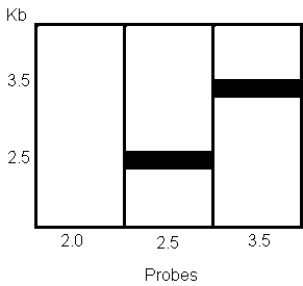Essay
A chimeric plasmid contains vector DNA ligated to a fragment of chromosomal mouse DNA that is suspected of containing the obese gene.As a first step,a restriction map of the DNA clone was constructed.The DNA was digested with two restriction enzymes,BopI and ZapII,with the following results:
a)From these data,answer the following questions.
(1)How large is the entire DNA clone?
(2)Is the clone linear or circular?
(3)Draw a restriction map consistent with these data.Include all BopI and ZapII sites and the physical distances between them.
b)To better identify the location of the mouse chromosomal DNA on this chimeric plasmid,mouse genomic DNA was digested with ZapII,run on a gel,and analyzed using the Southern blot technique.The Southern blot was probed with radiolabeled Zap II DNA fragments from the plasmid DNA.Three lanes each containing the same amount of Zap II-digested chromosomal DNA were each probed with a different fragment from the plasmid.Autoradiograms showed the following: What is the maximum amount of mouse DNA present in the clone? Why didn't the 2.0-kb ZapII fragment hybridize to the mouse DNA? 
Correct Answer:

Verified
a)
1)8.0 kb
2)A circular plasmid is the ...View Answer
Unlock this answer now
Get Access to more Verified Answers free of charge
Correct Answer:
Verified
1)8.0 kb
2)A circular plasmid is the ...
View Answer
Unlock this answer now
Get Access to more Verified Answers free of charge
Q27: A linear molecule of DNA 9 kb
Q28: A plasmid vector has a gene for
Q29: In the Sanger sequencing method,the use of
Q30: The autoradiogram shown was generated by the
Q31: The intermediate temperature cycle (72°C)in the polymerase
Q33: The cDNA for a eukaryotic gene B
Q34: Recombinant DNA techniques typically require the action
Q35: In Southern and Northern blotting,the probe being
Q36: In the study of genetics,a "library" denotes:<br>A)the
Q37: A linear DNA molecule has n target